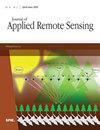太阳扩散器稳定性监测器太阳视图揭示的 SNPP VIIRS 太阳矢量定向知识误差
IF 1.4
4区 地球科学
Q4 ENVIRONMENTAL SCIENCES
引用次数: 0
摘要
不准确的太阳矢量方位知识会大大降低可见红外成像辐射计套件(VIIRS)的校准结果。我们开发了一种方法,利用苏米国家极轨伙伴关系(SNPP)VIIRS太阳扩散器稳定性监测器(SDSM)太阳视图数据来评估用于在轨辐射校准的星载校准器中间产品(OBCIP)文件中太阳角度的知识准确性。我们在 2013 年应用了这一方法的初始版本,发现太阳偏角的相对误差在 0 至 0.17 度之间。相对误差参考了2012年2月15日至16日发生的SNPP卫星偏航机动时间的误差。根据目前方法得出的长期任务结果显示,太阳矢量角知识误差从任务初期一直持续到任务第1129天(2014年11月30日)。误差逐年起伏,最大的太阳偏角误差从第一年的0.17度增加到第三年的0.19度,这与2014年初实现的太阳矢量误差根源认识相吻合。通过重新处理 OBCIP 文件,我们发现太阳矢量偏角和方位角知识误差的偏差接近零。这种方法的探测极限在很大程度上取决于 SDSM 探测器对太阳角度采样的精细程度。利用 SDSM 每天运行一次时收集的 SDSM 太阳视图数据,这种方法产生的太阳偏角和方位角探测标准偏差分别为 0.013 度和 0.024 度。根据 3 西格玛标准,在检测极限时,太阳方位误差导致的校准误差为 0.088%。这种方法可用于其他地球轨道传感器。本文章由计算机程序翻译,如有差异,请以英文原文为准。
SNPP VIIRS solar vector orientation knowledge error revealed by solar diffuser stability monitor sun views
Inaccurate solar vector orientation knowledge can considerably deteriorate calibration results for the Visible Infrared Imaging Radiometer Suite (VIIRS). We develop a methodology to use the Suomi National Polar-orbiting Partnership (SNPP) VIIRS solar diffuser stability monitor (SDSM) sun view data to assess the knowledge accuracy of the solar angles that reside in the onboard calibrator intermediate product (OBCIP) files used for on-orbit radiometric calibration. We applied an initial version of this methodology in 2013 and found that the solar declination angle had a relative error that varied between ∼0 deg to 0.17 deg. The relative error is referenced to the error at the SNPP satellite yaw maneuver time that occurred on February 15 to 16, 2012. Our mission long results from the current methodology show that the solar vector angular knowledge error occurred from the early mission until mission day 1129 (November 30, 2014). The error undulates yearly with the largest error in the solar declination angle increasing from ∼0.17 deg in the first year to 0.19 deg in the third year, agreeing with the solar vector error root cause understanding realized in early 2014. With the reprocessed OBCIP files, we find the solar vector declination and azimuth angular knowledge errors have near zero biases. The detection limit of this methodology strongly depends on how finely the solar angle is sampled by the SDSM detectors. With the SDSM sun view data collected when the SDSM operated once per day, this methodology yields detection standard deviations of 0.013 deg and 0.024 deg for the solar declination and azimuth angles. With a 3-sigma criterion, at the detection limits, the solar orientation errors result in a calibration error of 0.088%. This method can be applied to other Earth-orbiting sensors.
求助全文
通过发布文献求助,成功后即可免费获取论文全文。
去求助
来源期刊

Journal of Applied Remote Sensing
环境科学-成像科学与照相技术
CiteScore
3.40
自引率
11.80%
发文量
194
审稿时长
3 months
期刊介绍:
The Journal of Applied Remote Sensing is a peer-reviewed journal that optimizes the communication of concepts, information, and progress among the remote sensing community.
 求助内容:
求助内容: 应助结果提醒方式:
应助结果提醒方式:


